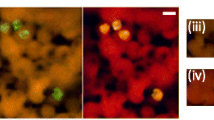Summary
A highly sensitive non-radioactive DNAin situ hybridization procedure is described that enables detection and unequivocal identification of various developmental stages of human and rodent malaria parasites. Using biotinylated species-specific DNA probes, erythrocytic parasites can be specifically stained in blood smears. Similarly exoerythrocytic stages can be visualized in cell culture and in sections of paraffin-embedded liver. In blood smears, the hybridization procedure provides a rapid detection of (low) parasitemia and species-determination for experienced microscopists at 100 to 400x magnification. Moreover, the procedure can be applied even after previous Giemsa staining of the preparation, enabling revision of patient smears which were difficult to read after routine Giemsa staining.
Similar content being viewed by others
References
Ferreira, A., Enea, V., Morimoto, T. &Nussenzweig, V. (1986) Infectivity ofPlasmodium berghei sporozoites measured with a DNA probe.Mol. Biochem. Parasitol 19. 103–9.
Lanar, D. E., McLaughlin, G. L., Wirth, D. E., Barker, R. F., Zolg, W. E. &Chulay, J. D. (1989) Comparison of thick films,in vitro culture and DNA hybridization probes for detectingPlasmodium falciparum malaria.Am. J. Trop. Med. Hyg. 40, 3–6.
McLaughlin, G. L., Collins, W. E. &Campbell, G. H. (1987) Comparison of genomic, plasmid, synthetic and combined DNA probes for detectingPlasmodium falciparum DNA.J. Clin. Microbiol. 25, 791–5.
Meis, J. F. G. M., Ponnudurai, T., Mons, B., Belkum, A. Van, Eerd, P. Van, Druilhe, P. &Schellekens, H. (1990)Plasmodium falciparum: Studies on mature exoerythrocytic forms in the liver of the chimpanzee,Pan troglodytes.Exp. Parasitol. 70, 1–11.
Mons, B. &Janse, C. J. (1990) Detection and analysis of parasitic infections. InFlow Cytometry in Hematology (edited byLaerum, O. D. &Bjerkness, R.) London: Academic Press (in press).
Nüssler, A., Follezou, J. Y., Miltgen, F. &Mazler, D. (1989) Effect of irradiation onplasmodium sporozoites depends on the species of hepatocyte infected.Trop. Med. Parasitol. 40, 468–9.
Pace, T., Ponzi, M., Dore, E. &Frontali, C. (1987) Telomeric motifs are present in a highly repetitive element in thePlasmodium berghei genome.Mol. Biochem. Parasitol. 24, 193–202.
Patarapotikul, J. &Langsley, G. (1988) Chromosome size polymorphism inPlasmodium falciparum can involve deletion of the subtelomeric pPFrep20 sequence.Nucleic Acids Res. 16, 4331–40.
Payne, D. (1988) Use and limitations of light microscopy for diagnosing malaria at the primary health care level.Bull. WHO 66, 621–6.
Ponzi, M., Janse, C. J., Dore, E., Scotti, R., Pace, T., Reterink, T. F. J., Berg, F. M. Van Den &Mons, B. (1990) Generation of chromosome-size polymorphism duringin vivo mitotic multiplication ofP. berghei involves both loss and addition of subtelomeric repeat sequences.Mol. Biochem. Parasitol. 41, 73–82.
Rickman, L. S., Oberst, R., Sangalang, R., Chulay, J. D., Long, G. W., Cabanban, A., Smith, J. I. &Hoffman, S. L. (1989) Rapid diagnosis of malaria by acridine orange staining of centrifuged parasites.Lancet,I, 68–71.
Siute, G. T. &Sodeman, T. M. (1973) Identification of malaria parasites by fluorescence microscopy and acridine orange staining.Bull. WHO 48, 591–6.
Sigter, C. I., Leland, P. &Hollingdale, M. E. (1984)In vitro infectivity of irradiatedPlasmodium berghei sporozoites to cultured hepatoma cells.Am. J. Trop. Med. Hyg. 33, 544–7.
Van Den Berg, F. M., Jiwa, M., Rook, J. &Geelen, J. L. M. C. (1988) Analysis and isolation of HCMV DNA by field inversion gel electrophoresis.J. Gen. Virol. 69, 699–704.
Van Den Berg, F. M., Schipper, M. E. I., Jiwa, M., Rook, J. &Van de Rijke, F. M. (1989) Implausibility of an etiological association between cytomegalovirus and Kaposi's sarcoma shown by four techniques.J. Clin. Pathol. 42, 128–31.
Van Der Loos, C. M., Das, P. K., Oord, J. J. Van Den &Houthoff, H. J. (1989) Multiple immunoenzyme staining techniques. Use of fluoresceinated, biotinylated and unlabeled monoclonal antibodies.J. Imm. Meth.,117, 45–52.
Van Der Loos, C. M., Volkers, H. H., Rook, R., Van Den Berg, F. M. &Houthoff, H. J. (1989) Simultaneous application of in situ DNA hybridization and immunohistochemistry on one tissue section.Histochem. J. 21, 279–84.
Waters, A. P. &McCutchan, T. F. (1989) Rapid sensitive diagnosis of malaria based on ribosomal RNALancet, II, 1343–6.
WHO (1986) The use of DNA probes for malaria diagnosis: Memorandum from a WHO meeting.Bull. WHO 64, 641–52.
Author information
Authors and Affiliations
Rights and permissions
About this article
Cite this article
Van Den Berg, F.M., Van Amstel, P.J., Janse, C.J. et al. Detection of different developmental stages of malaria parasites by non-radioactive DNAin situ hybridization. Histochem J 23, 109–115 (1991). https://doi.org/10.1007/BF01047455
Received:
Revised:
Issue Date:
DOI: https://doi.org/10.1007/BF01047455




